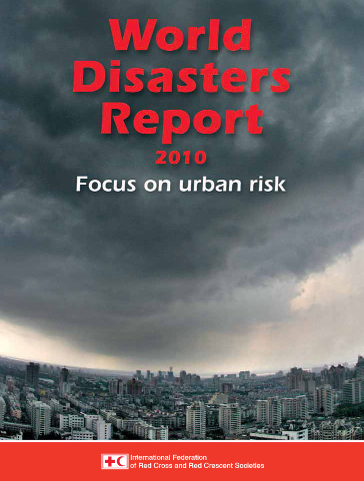
The signs of our vulnerability to urban risk are everywhere. An earthquake can bring hospitals, schools and homes tumbling down with unspeak- ably tragic consequences. A volcano can throw city airports into chaos. Flood waters can turn well-kept streets into detritus-strewn canals. The drug trade can turn an inner city into a war zone. An epidemic can spread rapidly through a crowded slum. As the pendulum of human development swings increasingly away from the country- side to the city, we see that rapid urbanization and population growth are combining to create enormous new challenges for the humanitarian community and pushing us out of our comfort zone to deal with a strange new urban world. When it comes to the impact of natural disasters, well-run cities can be among the safest places on earth. They can also be the best places to raise a family, for schooling, healthcare and employment. You can expect to live longer in a city. Cities can also be the most dangerous places on earth for those who live in an urban environment where the authorities have little presence and where the will and the resources are lacking to ensure basic social services, food security, policing, running water, sewerage and respect for building codes. This urban risk divide is a major challenge for humankind in the 21st century if we are to ensure that the worldwide movement from the countryside to cities does not fuel a growth in sickness and deaths from the re-creation of 19th century-like public health hazards exacerbated by exposure to risks generated by climate change and the threat of pandemics. The stresses and strains of urban living can be compounded immeasurably for those who end up living on the peripheries of cities in low- and middle-income countries, barely surviving on one US dollar or less a day. Despite the heartbeat of commerce and other signs of vibrant life which pulsate through many informal urban settlements, slum life can be nasty, brutal and short for many inhabitants as they lose out in a Darwinian struggle for survival against disease, malnutrition, illiteracy, crime and natural disasters. It is this urban ‘underclass’ that should concern the humanitarian community most. Their numbers are almost 1 billion and they are growing at the rate of 10 million annually despite commendable efforts to reach the Millennium Development Goal on shelter in some parts of the world. Before the tide of urbanization leaves us behind, the humanitarian community needs to bring about a sea-change in how we respond to these vulnerable people, and how we engage with governments who are struggling to understand what is happening in their cities and finding it difficult to resource an adequate response. This year’s World Disasters Report does not have all the answers but it does have sound advice on how the urban risk divide between the developing world and the developed world can be reduced. It also highlights how, in a globalized world, a deficiency on one side of the world can create problems for us all. Urbanization can be a strong bulwark against the worst that climate change is throw- ing at us. Where there is good urban governance, you find economies of scale in terms of risk reduction and response capacities. Where there is good urban governance, you will also find citizens who are empowered and active in their communities because they have security of tenure and their housing, land and property rights are respected. The challenge for humanitarian actors is to find new and concrete ways of engag- ing with local authorities and vulnerable communities to ensure that risk reduction is all encompassing and not simply focused on the obvious and on the post-disaster clean-up. It is clear from many examples in this report that urban communities are capable of finding their own solutions, asserting their rights and playing a full role in post-disaster recovery and risk reduction but that many need external support which is appropriate to their circumstances. One man’s flood drain is another man’s home. This paradox – the elimination of one risk to replace it with another – must encourage us to engage intelligently with com- munities struggling to survive along the fault lines of urban risk. In the long term, if we are looking after the vulnerable in our cities, we are looking after ourselves.
Resource collections
- UN Habitat - Urban Response Collection
- Urban Response - Urban Crisis Preparedness and Risk Reduction
- Urban Response Collection - Community Engagement and Social Cohesion
- Urban Response Collection - Economic Recovery
- Urban Response Collection - Environment and Climate Change
- Urban Response Collection - Housing, Land and Property
- Urban Response Collection - Urban Crisis Response, Recovery and Reconstruction
- Urban Response Collection - Urban Resilience